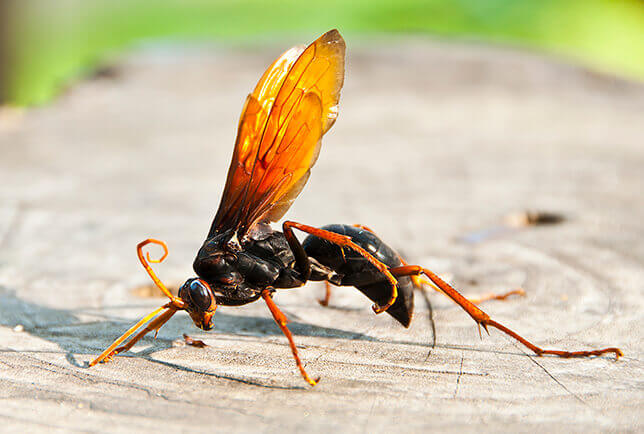What Do Wood Wasps Look Like?

Wood wasps common to New England include two different subspecies. Sirex wood wasps are an inch long with a shiny blue head and thorax. Males have thick black legs and an orange abdomen. Females have orange limbs as well as a spike at the end of their bodies that protects their egg-laying organs. This feature is often mistaken for a stinger.
Adult horntails have cylindrical bodies, black antennae, red or yellow markings, and four clear wings. Like sirex wood wasps, females have a spear-like ovipositor that resembles a stinger. Males are smaller and more colorful. The larvae of both subspecies have soft, milky-white bodies.
How Can I Tell if I Have a Wood Wasp Problem?
Wood wasps lay eggs inside conifers and elm, hickory, and maple trees, among others. Typically, the only indication of a wood wasp issue involves trees or hardwood plants. Some signs include:
- High Populations – Horntails don’t usually gather in large numbers, so if you see a lot of them resting on woodpiles or tree stumps, they could be breeding on your property.
- Larval Tunnels and Exits – Wood wasp larvae bore through their host tree and create lengthy tunnels filled with sawdust-like debris. When exiting the tree, the pests leave big holes in the wood.
- Weakened Trees – Larval feeding damages sapwood and heartwood inside trees. Those affected often have wilted, red-brown foliage and may be more susceptible to wind breakage.
How Do Wood Wasps Get Inside Homes and Businesses?
Wood wasps thrive in the vast pine forests and temperate climate of New England, but these pests rarely enter houses. However, firewood or infested lumber used in a home’s construction can be a problem. Wood wasp larvae can take up to 5 years to mature. The sudden presence of the adult pests indoors takes people completely by surprise.
Like homes, commercial spaces built with infested wall studs or subflooring may see the pests emerge long after construction. Fortunately, wood wasps do not bore into dry, finished lumber and are unlikely to reinfest houses or businesses. Conifer tree farms and plant sanctuaries are the most vulnerable to wood wasp infestations.
Are Wood Wasps Dangerous?
Though they can eat their way through timber, horntails don’t bite people. However, the pests can damage hardwood trees, especially those that are weak, dying, or recently cut. Additionally, when wood wasps emerge from lumber in buildings, they free themselves by chewing through wallboard, plaster, carpeting, and linoleum, leaving large, unsightly holes behind.
How Can I Prevent Wood Wasp Infestations?
To prevent a wood wasp infestation, be sure to use dry, treated lumber for construction and home projects. Also, avoid leaving unused firewood indoors. If you have concerns about horntail issues on your property, call Waltham Pest Services for expert assistance.